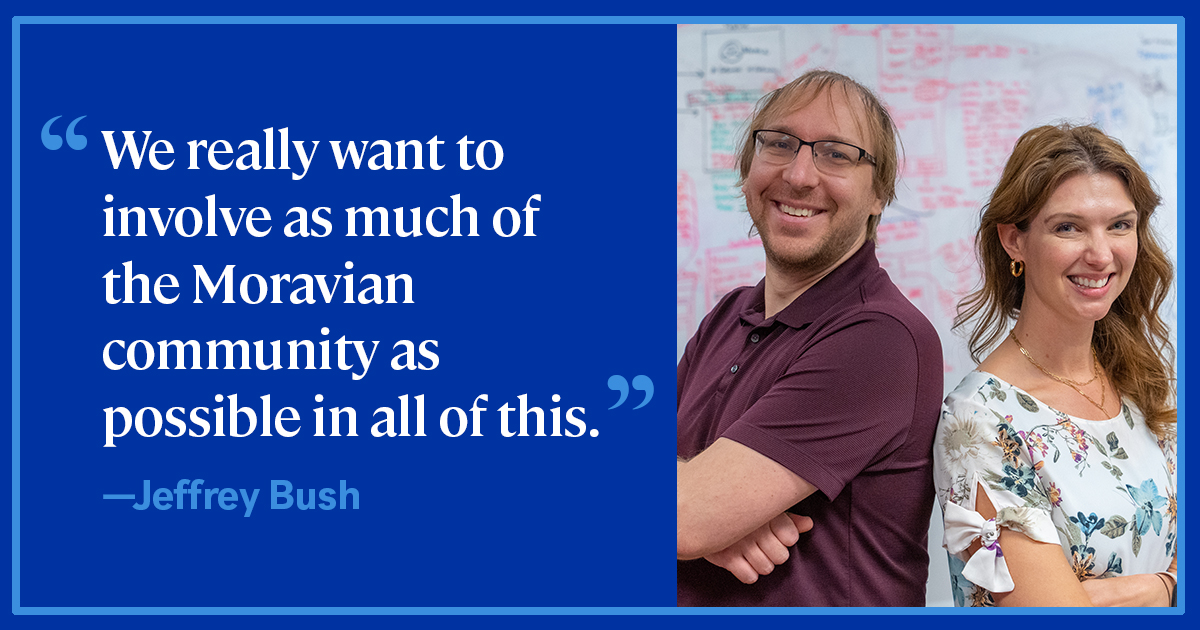Partners in Healthcare
Put an occupational therapist and a 3D printing specialist together and what will they come up with? Assistive devices for people with disabilities, a unique app, and superior educational opportunities for students.
By Meghan Decker Szvetecz ’08
Photographs by Katie Creighton
For a person living with a disability, access to everyday assistive devices can make all the difference in increasing independence and quality of life. A mouthwash holder for an easier pour, a stylus to type on a smartphone, a dibber to plant flower bulbs—small, handheld devices such as these can be fabricated by a 3D printer in a matter of hours from plastic filament that costs anywhere from a few cents to a few dollars and creates a durable product.
Under the leadership of Jeff Bush, assistant professor of computer science and head of the 3D printing lab, and Sara Benham, assistant professor of occupational therapy (OT), Moravian University has been providing custom 3D-printed assistive devices for residents of the Good Shepherd Home–Raker Center in south Allentown. Raker is a long-term care residence for people with severe physical disabilities.
“Good Shepherd chose Moravian over Lehigh, with its engineering departments and many resources, because we have occupational therapy,” says Bush.
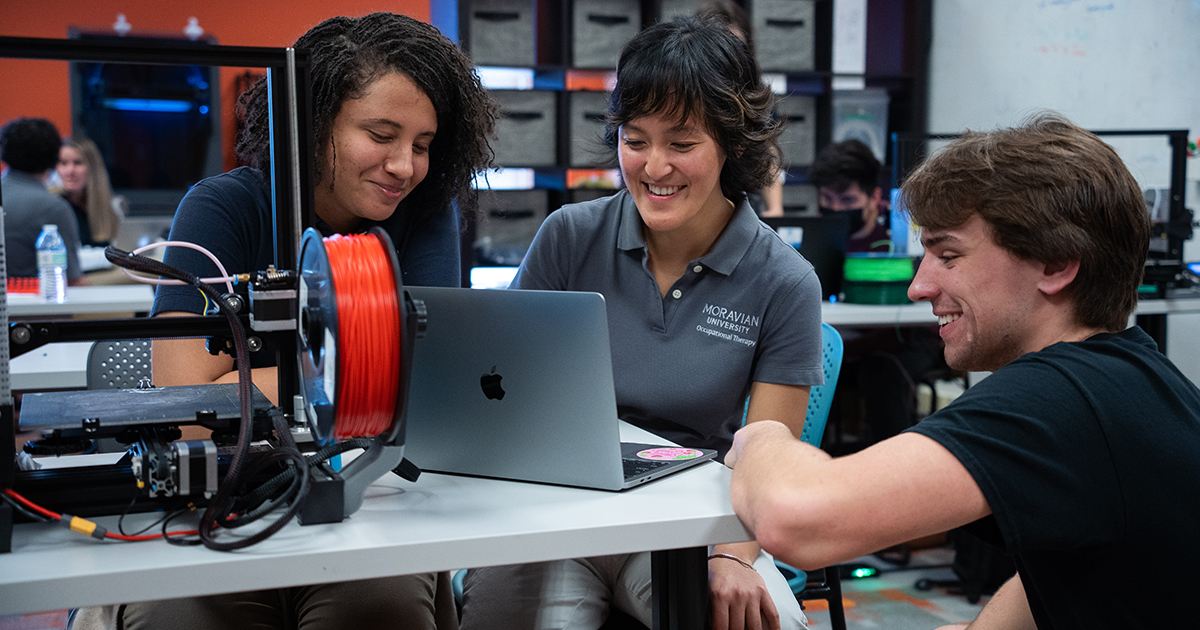
Left to right: Students Kyra Shields, Rosh Bautista, and Joe Lepoidevin ’22 print the loom holder they’ve designed for a woman with cerebral palsy.
An Educational Opportunity
The partnership has created an important opportunity in real-world experiential learning for Moravian students. Students from Benham’s occupational therapy course and Bush’s 3D printing class work together in small teams to make assistive devices for Raker residents. OT students meet with residents at the Raker Center to ask what would be helpful and to assess their abilities. They then return to Moravian and collaborate with students proficient in 3D printing to design and make the desired device. Once a model is created, OT students take it back to the residents they are helping to determine what adjustments might be required. Further tweaking produces final customized assistive devices that are presented to grateful residents.
“I love that students get to make something usable that provides a specific functionality to someone who otherwise would not have that ability,” says Bush.
Last spring, Joe Lepoidevin ’22, a psychology major who fell in love with 3D printing, teamed up with then first-year OT students Rosh Bautista and Kyra Shields. Together they improved on a holder for a knitting loom that would make using the loom easier for a woman with cerebral palsy.
“The experience was awesome,” says Lepoidevin. “It was intense but a fun challenge. It was cool to make something specific and unique, and I learned a little bit about occupational therapy.”
“I really enjoyed being able to collaborate with a student from a different discipline,” says Bautista. “Working with a resident at the Good Shepherd Home was also a good experience.”
As part of the semester-long collaboration, the 3D printing students teach their OT team members how to use the printers and explain the benefits of 3D printing: savings in costs and time and durability. OT students participated in every aspect of making the assistive device, from designing it on the Onshape CAD platform to the final printing.
“My aim is to prepare students within Moravian’s mission of transformative leadership in a world of change,” says Benham, “and this includes being at the forefront of the integration of new technology in occupational therapy. Currently, clinicians usually require a 3D printing expert to facilitate the printing process. My goal is to prepare our OTs to be proficient in 3D printing so they can do it themselves and be a leader in their clinical placements and in their future employment settings.”
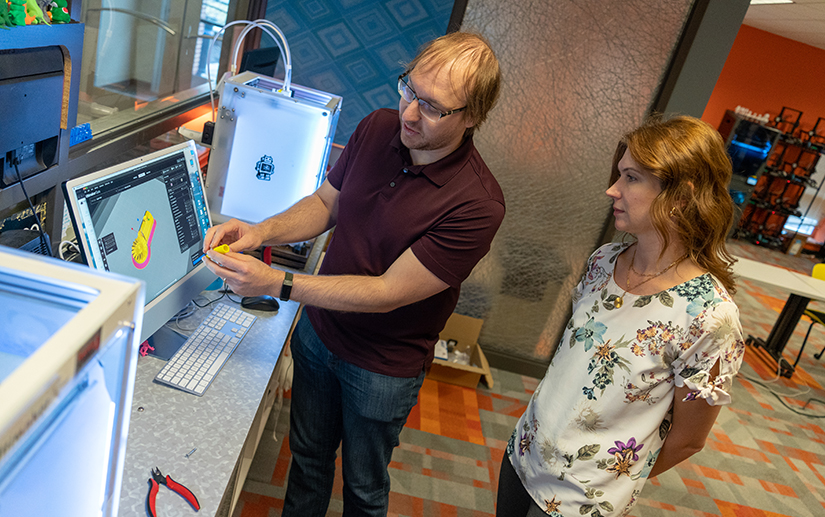
Jeffrey Bush, head of the 3D printing lab and assistant professor of computer science, and Sara Benham, assistant professor of occupational therapy, check on the printing of part of an assistive device.
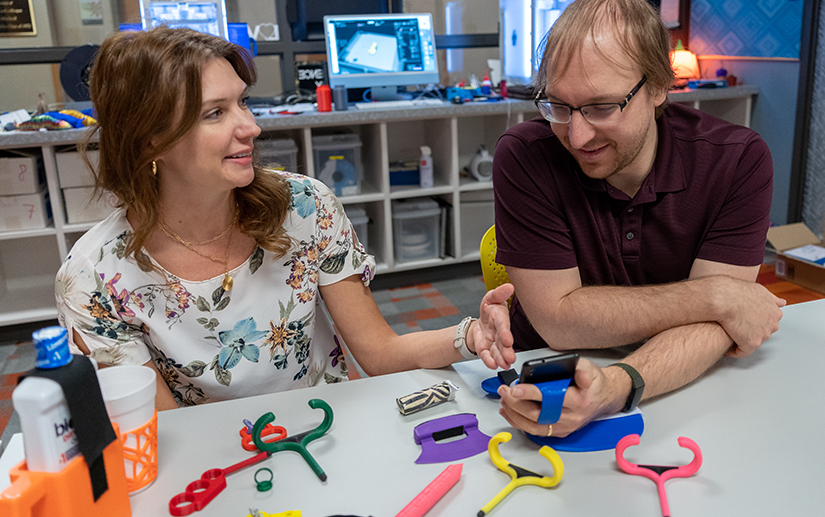
Benham shows Bush a smartphone holder.
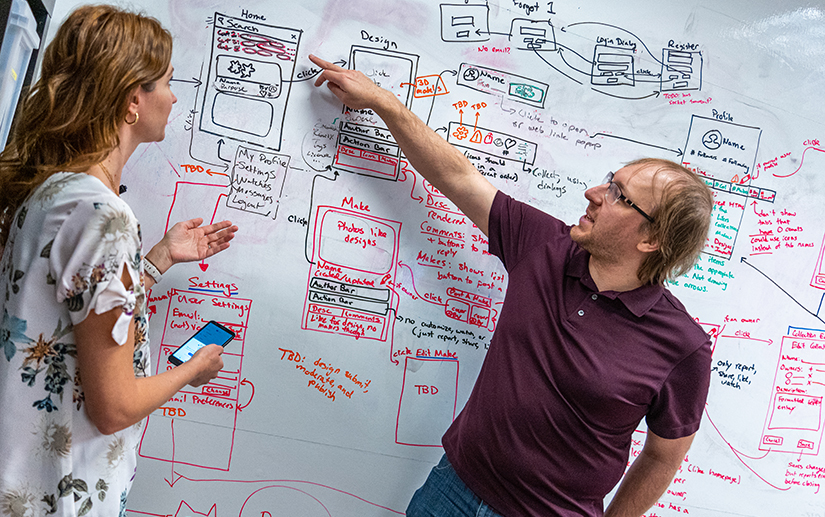
Benham and Bush review the flowchart for the app they are developing, 3D Adapt.
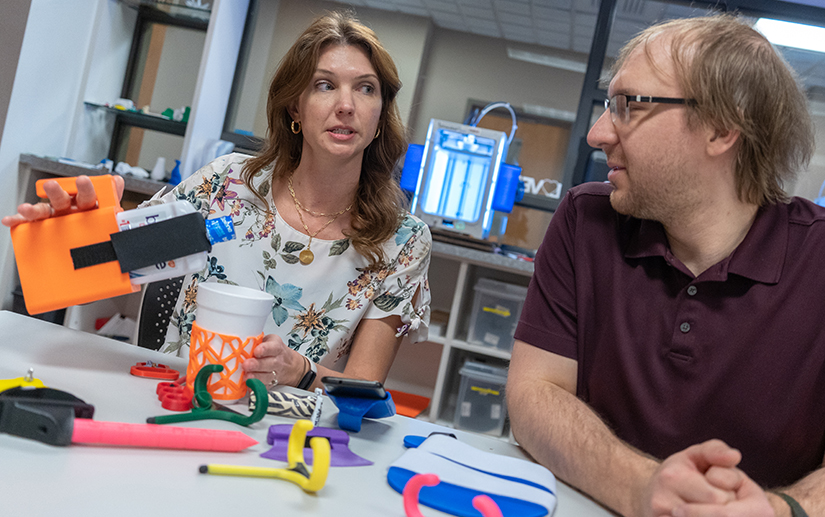
Benham demonstrates how a bottle holder makes pouring liquids easier.
3D Adapt
The residents of Good Shepherd’s Raker Center are fortunate to have access to Moravian University’s expertise and resources in acquiring assistive devices without charge, but Benham and Bush are also looking beyond the relationship with Good Shepherd. They want to create easy access to devices for all persons with a disability. These devices are often not covered by health insurance, so it’s up to the person with a disability to source and pay for them—no easy feat when that person must cull through makerspace websites for available 3D design files that include everything from fidget spinners to cosplay props. With help from students across majors, Benham and Bush are developing a solution they hope will remove barriers to device access: an app called 3D Adapt. Partly underwritten by a grant from the App Factory to Support Health and Function of People with Disabilities*, 3D Adapt will feature an accessible interface and a simple database of well-curated devices.
3D Adapt is geared exclusively to people living with a disability and the clinicians who assist them. Users can download an assistive device design file and take it to a publicly accessible 3D printer (at a library, for example) or have their device printed and shipped by a 3D printing service.
The market for assistive devices is big. According to 2020 figures from the US Census Bureau,
more than 40 million Americans live with a disability. Globally, more than 1 billion disabled individuals
need at least one assistive technology device.
Benham is currently organizing the database and tagging devices for the appropriate categories and subcategories. “I’m working on the best way to categorize each of these devices based on the World Health Organization’s International Classification of Functioning, Disability and Health so that it’s better used widely through all clinical professions,” says Benham. She hopes that the app will serve as a platform where individuals with disabilities can collaborate with their clinicians. When the app is published this fall, it will feature 10 to 20 customizable models and 200 models that will not be customizable.
What made Benham and Bush’s grant proposal stand out, they learned, was the fact that their app can be produced entirely at Moravian, resulting in a budget of just under $29,000. Rather than hiring an app developer, Bush recruited senior Shane Houghton, a computer science and graphic design double major, to write code for the app. Bush says that Houghton is excited to be “making something that will actually be published, people will actually use, and is going to be helping people.”
Grant funding will also be allocated to graphic design students from Moravian University’s Studio South, and when the app is functional this summer, OT students can participate in focus groups. “We really want to involve as much of the Moravian community as possible in all of this,” says Bush.
Part of the grant proposal includes promoting their project at an upcoming conference and publishing a peer-reviewed paper. Bush will also write a business plan for how the app can sustain itself to cover the cost of hosting. With future funding, Benham sees so much potential for this project to grow and evolve. “I think that the opportunities will turn into more opportunities for students,” she says. “We’re bringing all of the talents of our faculty and students together.”
*Funded by a grant to the Raker Center from the National Institute on Disability, Independent Living and Rehabilitation Research (NIDILRR) in the US Department of Health and Human Services
Meghan Decker Szvetecz ’08 is a freelance writer with a background in higher education communications.

